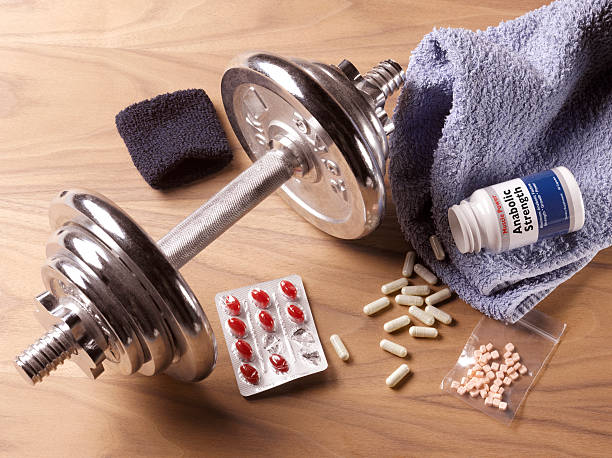
Anabolic androgenic steroids are synthetic substances that mimic the masculinising effects of testosterone and can be both image and performance enhancing drugs. Capable of promoting muscle growth and strength, they can also lead to the development of male characteristics.
Initially, anabolic steroids had legitimate medical uses. Conditions like delayed puberty, muscle loss due to illness, and hypogonadism( lack of testosterone production) were treated by steroids, but their performance enhancing capabilities started to be used from the 1950s.
Foundations of Steroid Use in International Sport
The most notable early steroid usage in high level sport was during the 1954 World Weightlifting Championships. Soviet athletes displayed enhanced muscle mass a had a unmatched performance superiority, which many attributed to their use of testosterone. This is considered the first use of an anabolic steroid in an international athletic competition.
Steroid use grew, particularly in the 1970s and 1980s, both at professional and amateur levels. State-sponsored doping programmes operated in East Germany, the Soviet Union, and other Soviet satellite states, which only fully came to light in later years, despite the many years of suspicion and finger pointing.
The adverse health effects and the unfair advantage provided by anabolic steroid use led to increased scrutiny and regulation in sport. The use of performance-enhancing steroids in sport is banned by most major sporting bodies, including the International Olympic Committee (IOC) and the World Anti-Doping Agency (WADA).
Despite this, anabolic steroid misuse remains a significant issue in professional and even some amateur sport. Modern doping has evolved to include sophisticated methods that are much harder to detect and continue to cause increasing headaches for drug testers and the relevant sporting bodies that have to deal with the issues that arise from doping cases.
Why is Steroid Use so Tempting for Athletes?
Athletes are often under immense pressure to perform well in competition, and this can tempt them to try and get the edge and misuse anabolic steroids, despite the risks. While anabolic steroids work and can significantly increase lean muscle mass, strength, and recovery speed, all of which enhance aid athletic performance, they are not without their negative effects.
It is the desire for quick improvements in performance and physical appearance that can make athletes tempted to look towards steroids as a shortcut to success. Naturally, athletes still have to undergo intense training and diet to achieve gains, but steroids promise faster and better results by artificially enhancing the body’s ability to build muscle and recover.
It’s not just athletes that are drawn to taking anabolic steroids. Societal standards that glorify muscular physiques can drive both men and women towards steroids misuse. In terms of physical transformations, before and after the use of steroids can show dramatic changes in body composition and increasing muscle mass.
These gains can be motivating to those seeking rapid improvements. However, these transformations come with the cost of potential long-term health consequences, including hormonal imbalances and organ damage.
Impact of Steroid Use in Professional Sport
To deter the use of performance-enhancing drugs, penalties have become more severe. Athletes may face suspensions from competitions, or even lifetime bans for repeated offences. For instance, penalties under the WADA code can include suspension from competition for two years for a first violation.
The use of steroids and other performance-enhancing drugs in sports also raise serious ethical issues, primarily around the concept of fairness. Using these substances can provide an unfair advantage, and undermining the integrity of the sport.
There are numerous high profile doping offences in sport, including Canadian sprinter Ben Johnson being stripped of the 100m title in the 1988 Olympics and Lance Armstrong losing his 7 Tour de France titles. Despite these examples, athletes are still looking to take risks with steroids and other doping methods to gain the competitive advantage.
Performance enhancing drug scandals affect the competitions themselves, and the public’s perception of sports can also be negatively affected by widespread doping scandals. The pro cycling tour, for example, has be dogged with accusations in the past that the majority of athletes were doping to some extent in order to improve athletic performance and not fall behind their competitors.
For athletes, their well-being can be affected by steroid misuse, with a number of potential serious side effects including hormonal imbalances and liver damage. The specific impact on women is particularly notable as steroids can potentially change physical appearance, cause a deeper voice and increased body hair. This can ultimately stigmatise female athletes.
Physical Health Risks of Anabolic Steroids Use
Anabolic steroid users are putting their health at risk when using performance enhancing drugs. There are a number of unwanted side effect of anabolic steroids use, the risks include the following:
1. Liver damage: Steroid use can lead to serious liver disease and conditions such as liver tumours and peliosis hepatis, a condition where blood-filled cysts form within the liver. Both of these conditions have the potential to be life-threatening.
2. Cardiovascular problems: Anabolic steroid use can exacerbate heart and blood vessel diseases by increasing bad cholesterol (LDL) levels and decreasing good cholesterol (HDL) levels. This can lead to high blood pressure, blood clots, and an overall increased risk of heart attack and stroke.
3. Hormonal imbalance: In men, steroids can cause testicular atrophy, decreased sperm production, and breast enlargement (gynecomastia). Women may experience changes such as a deeper voice, increased body hair, facial hair growth, menstrual irregularities, and an enlarged clitoris. These changes may be irreversible.
4. Severe acne and hair loss: Steroid use can significantly alter skin condition, leading to severe acne. Additionally, it can cause both men and women to experience hair loss.
5. Psychological effects: Steroid users may experience mood swings, increased aggression, and other mental health issues like depression.
6. Combined use with alcohol: The combination of steroids and alcohol is another critical concern. Alcohol can worsen the negative impacts of steroid uses, complicating health risks and potentially leading to dangerous interactions.
7. Impaired immunity: Anabolic steroids reduce the activity of the immune system, leaving the body more vulnerable to illness and infection.
8. Other risks: Using needles to inject steroids can increase the risk of contracting infectious diseases like HIV and hepatitis if the equipment is shared.
These health risks highlight the dangers associated with the non-medical use of steroids. They stress the importance of avoiding such drugs unless prescribed by a healthcare provider to treat legitimate medical conditions. Genuine reasons for steroid medication – which is actually corticosteroids and therefore different to anabolic steroids – include the treatment of eczema, asthma, joint pain and multiple sclerosis.
Impacts of Steroid Use & Withdrawal Symptoms
Anabolic steroids use can have very noticeable psychological effects on users which can affect both the personal relationships and professional life. Incidences of “roid rage, are not uncommon, whereby steroid users display sudden and extreme aggression and irritability.
Mood swings are also another impact of anabolic steroid user. Users may experience rapid shifts in mood, from euphoria to deep depression, which can be unpredictable and difficult to manage. These mood swings, combined with any bouts of aggression, can make social interactions and maintaining relationships difficult.
Dependency on anabolic steroids is also a serious concern. About a third of individuals who misuse steroids develop a dependence.
Steroid withdrawal can prove problematic, with a number of symptoms complicating attempts to quit. These symptoms are largely due to the hormonal imbalances caused by prolonged steroid use and can include depression, restlessness, fatigue, and lack of self-esteem and general well-being. Withdrawal can impact on the ability of individuals to function in their daily lives and as a result they may require medical intervention to manage both the physical and psychological effects.
Steroids and Their Impact on Youth and Amateur Athletes
Steroid risks are also present for adolescent and young amateur athletes who may be tempted to try and take a shortcut to success. Stunted growth may result from anabolic steroid use, as this can cause premature closure of growth plates in bones. Additionally, steroid use is linked to severe acne, liver damage, and increased risk of heart disease and strokes, with the risks heightened for younger people whose bodies are still developing.
The consequences of steroid use go far beyond the physical effects. The use of these banned substances and failed drug testing can lead to sporting sanctions, including bans from sporting events and loss of sponsorships, which can ruin an athlete’s reputation and sporting career as well as family relationships.
How InnerLife Recovery Can Help
Our tailored treatment programs at our luxurious facilities in Marbella, Spain provide you or a loved one with the best opportunity to finally shake off a steroid addiction and remain drug-free in the long-term.
Through medical intervention (where required), education and robust support systems, we at InnerLife Recovery aim to create an environment where good health is prioritised, ensuring the well-being of individuals and athletes who are trying to rid themselves of steroid misuse, sometimes maintained over a prolonged period.
If you or a loved one is struggling with addiction, our experienced team can help. We offer holistic, trauma-informed treatment that addresses both the addiction and the underlying emotional pain.
📞 Reach out today to learn more about our residential treatment programs. We’re here 24/7h available to help you recover and rebuild.
Contact us today for an obligation-free confidential consultation






